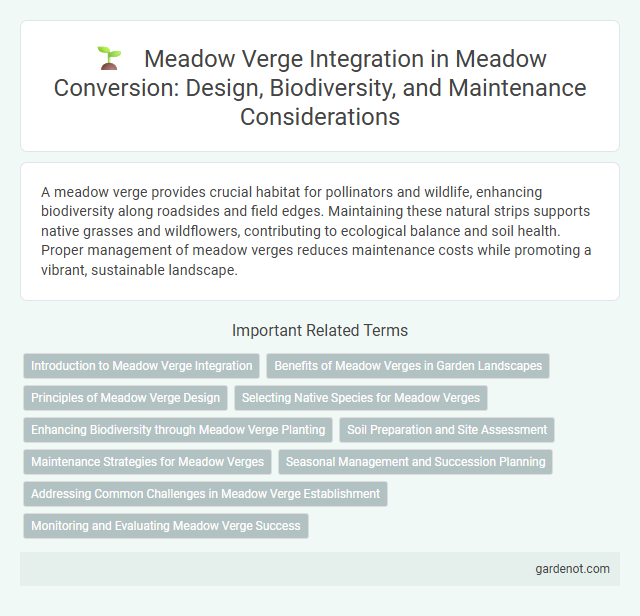A meadow verge provides crucial habitat for pollinators and wildlife, enhancing biodiversity along roadsides and field edges. Maintaining these natural strips supports native grasses and wildflowers, contributing to ecological balance and soil health. Proper management of meadow verges reduces maintenance costs while promoting a vibrant, sustainable landscape.
Introduction to Meadow Verge Integration
Meadow verge integration enhances road safety and biodiversity by transforming roadside margins into lush habitats filled with native wildflowers and grasses. This eco-friendly approach supports pollinators, reduces maintenance costs, and improves landscape aesthetics. Implementing meadow verges requires selecting site-specific plant species that thrive in local soil and climate conditions.
Benefits of Meadow Verges in Garden Landscapes
Meadow verges enhance garden landscapes by promoting biodiversity, supporting pollinators such as bees and butterflies, and reducing maintenance needs compared to traditional lawns. They improve soil health through diverse plant root systems and contribute to carbon sequestration, aiding environmental sustainability. Meadow verges also offer visually appealing, seasonal color variations that attract wildlife and create natural habitat corridors.
Principles of Meadow Verge Design
Meadow verge design prioritizes biodiversity enhancement by incorporating native wildflowers and grasses that support pollinators and local wildlife. Soil health and moisture levels are carefully assessed to select appropriate species that thrive naturally, reducing maintenance needs and promoting ecological balance. Strategic placement ensures visibility and safety on roadsides while maximizing habitat connectivity within urban and rural landscapes.
Selecting Native Species for Meadow Verges
Selecting native species for meadow verges enhances local biodiversity by supporting indigenous pollinators and wildlife. Native grasses such as Festuca rubra and wildflowers like Leucanthemum vulgare thrive in these habitats, ensuring ecosystem resilience and requiring minimal maintenance. Prioritizing region-specific plants improves soil health and creates sustainable, low-impact green corridors along urban and rural roadsides.
Enhancing Biodiversity through Meadow Verge Planting
Meadow verge planting significantly enhances biodiversity by creating habitats for pollinators such as bees, butterflies, and other beneficial insects. Native wildflowers and grasses adapted to local conditions support diverse wildlife populations and improve ecosystem resilience. Strategic planting of meadow verges also contributes to greater ecological connectivity, facilitating species movement and genetic exchange across fragmented landscapes.
Soil Preparation and Site Assessment
Soil preparation for meadow verge conversion involves testing pH levels, nutrient content, and soil texture to ensure optimal conditions for native wildflower growth. Conducting a thorough site assessment identifies existing vegetation, drainage patterns, and sun exposure, which influence plant selection and seeding strategies. Proper soil loosening and removal of invasive species enhance root establishment and promote biodiversity in meadow verge restoration.
Maintenance Strategies for Meadow Verges
Effective maintenance strategies for meadow verges emphasize seasonal mowing regimes that balance biodiversity conservation with aesthetic appeal. Selective cutting, typically once or twice annually after wildflowers have seeded, enhances plant diversity and supports pollinators such as bees and butterflies. Avoiding the use of herbicides and minimizing soil disturbance further promotes native species establishment and overall ecological health.
Seasonal Management and Succession Planning
Meadow verge seasonal management involves carefully timed mowing and controlled grazing to promote native wildflower regeneration and support pollinator habitats. Succession planning requires periodic soil disturbance and seed dispersal to prevent scrub encroachment and maintain biodiversity. Implementing adaptive management strategies helps sustain ecological balance and ensures long-term conservation success of meadow verges.
Addressing Common Challenges in Meadow Verge Establishment
Meadow verge establishment often faces challenges such as soil compaction, invasive weed competition, and insufficient local seed sourcing. Effective management involves addressing soil fertility through minimal disturbance techniques and strategic weed control to promote native species dominance. Utilizing locally adapted seed mixes tailored to regional ecosystems enhances plant resilience and biodiversity in meadow verge habitats.
Monitoring and Evaluating Meadow Verge Success
Monitoring meadow verge success involves systematic assessment of plant species diversity, growth rates, and pollinator activity to evaluate ecosystem health. Regular surveys using standardized protocols capture data on native wildflowers and insect populations, indicating habitat quality and resilience. Utilizing remote sensing and citizen science tools enhances data accuracy, supporting adaptive management practices for long-term meadow verge sustainability.
Meadow verge Infographic

 gardenot.com
gardenot.com